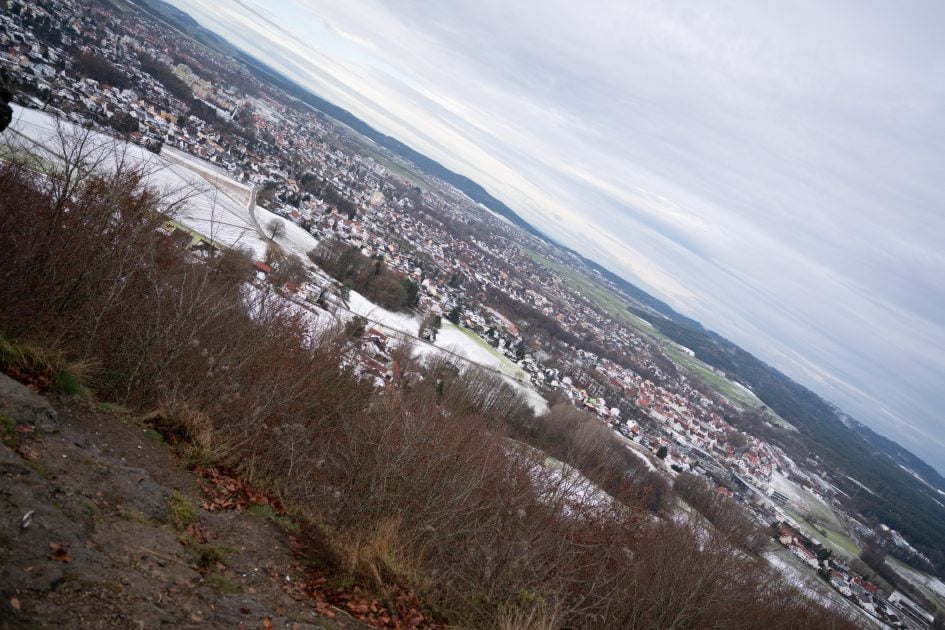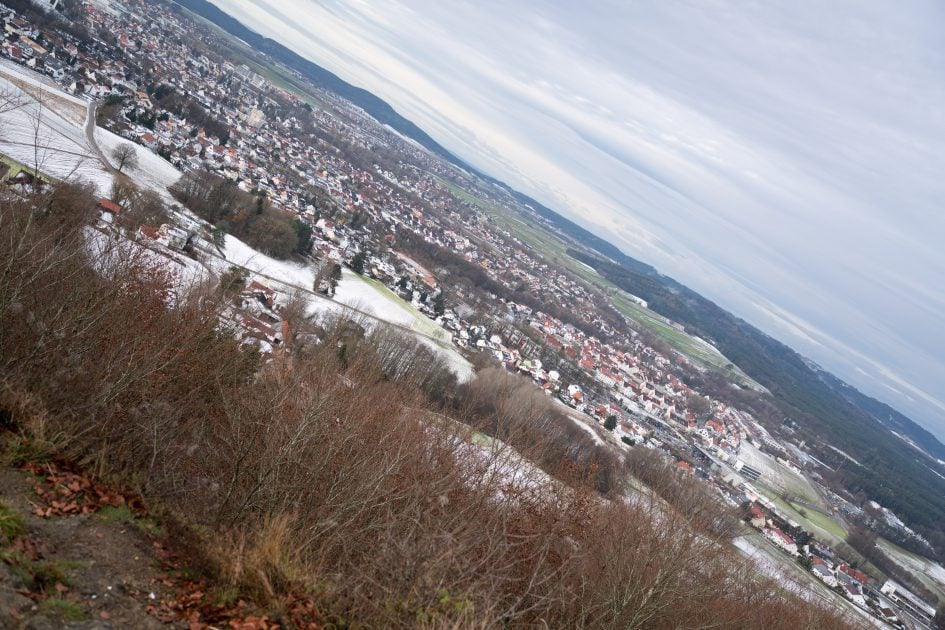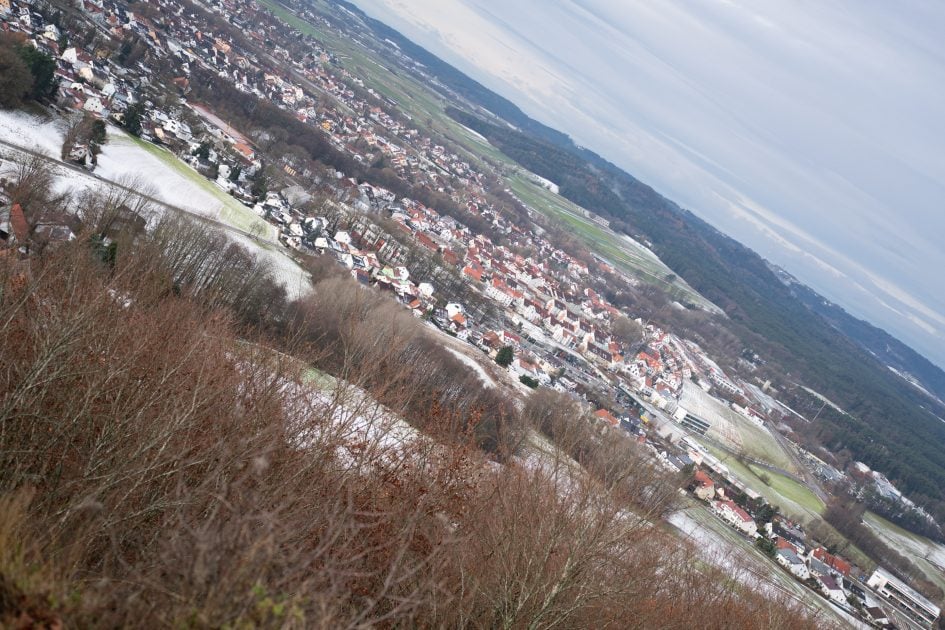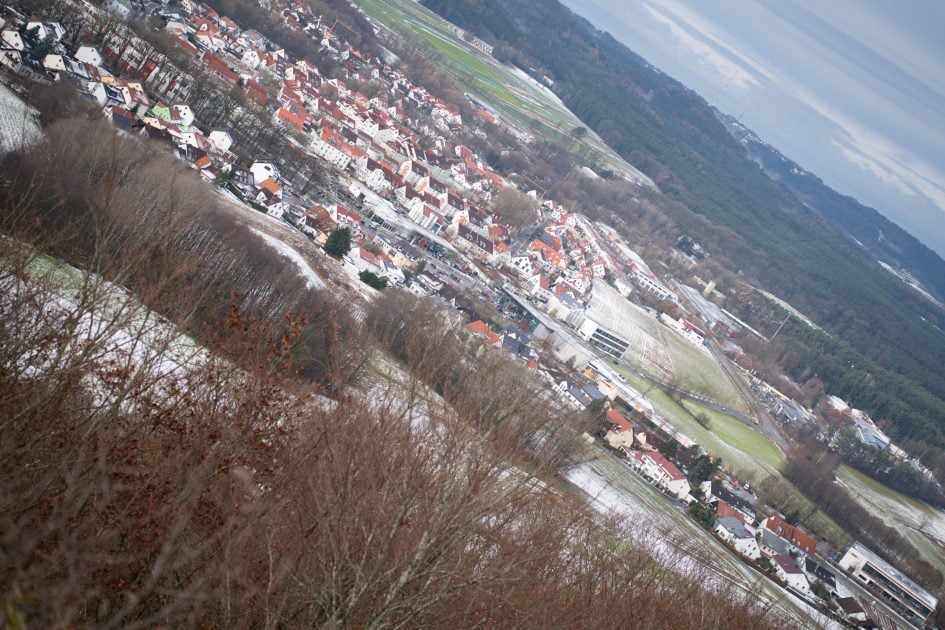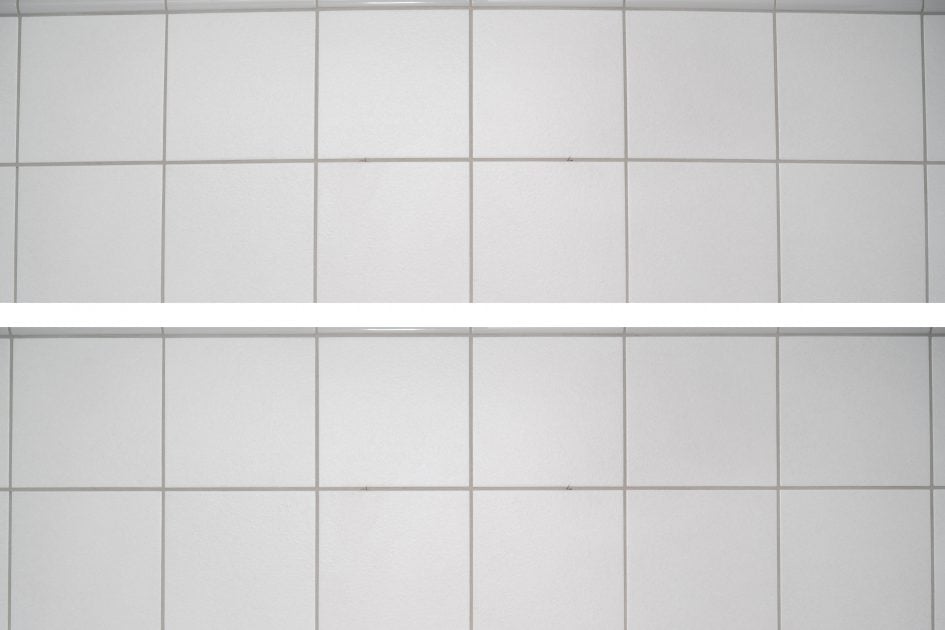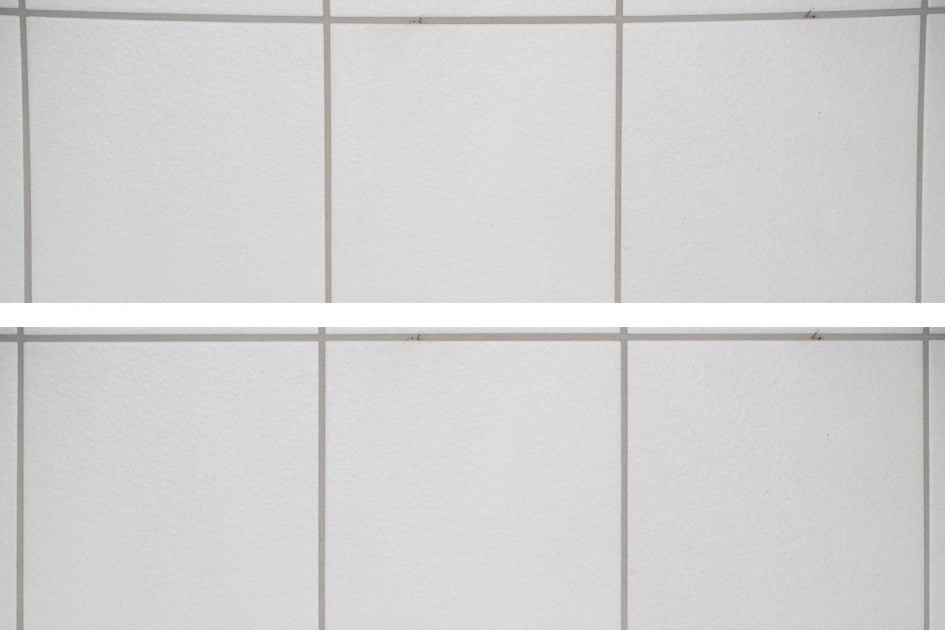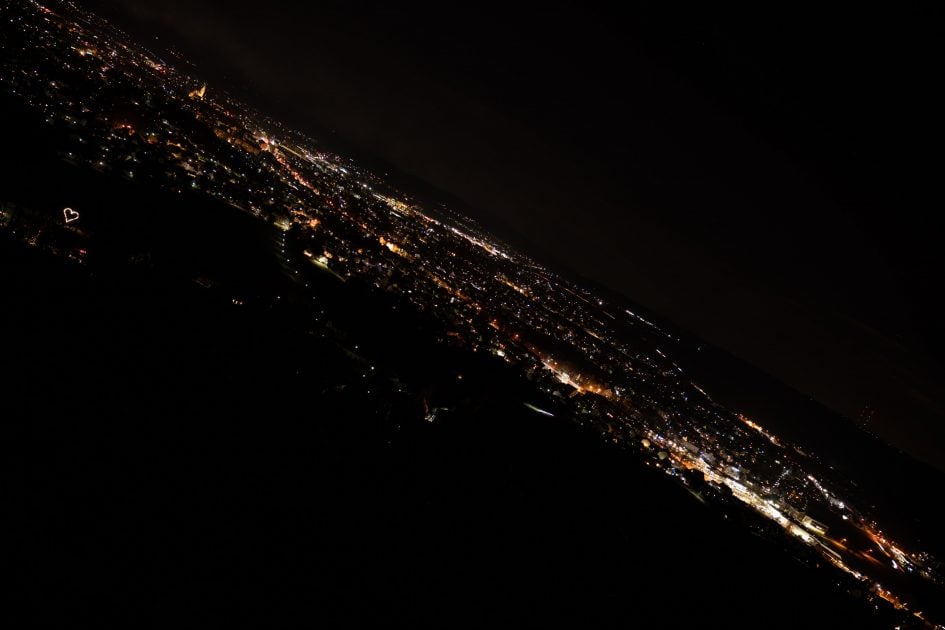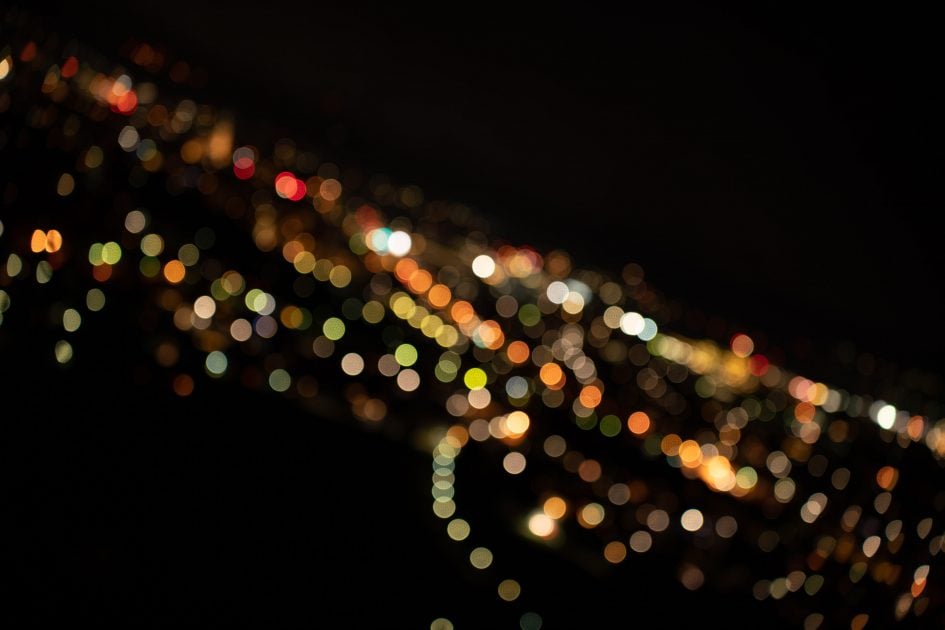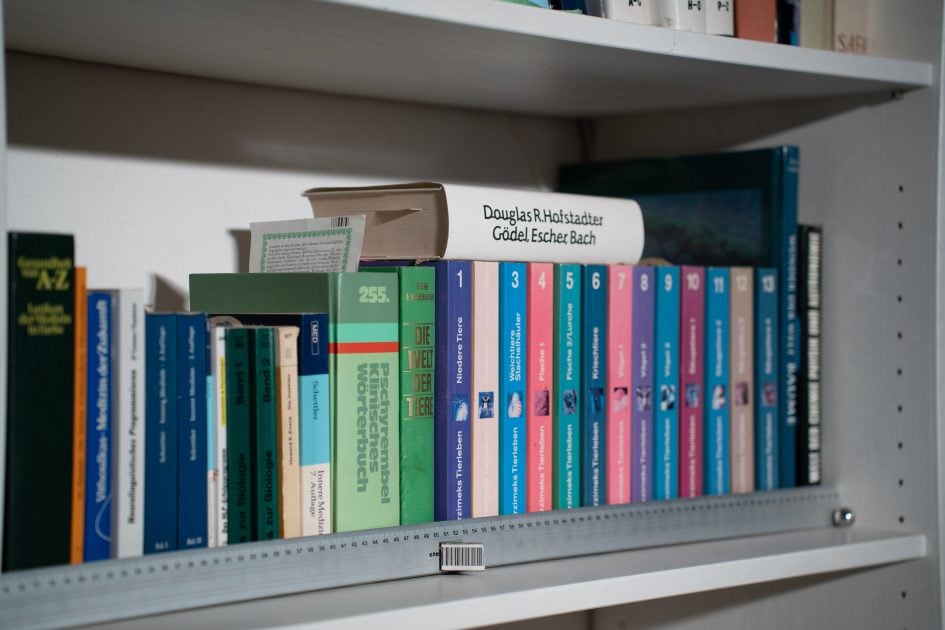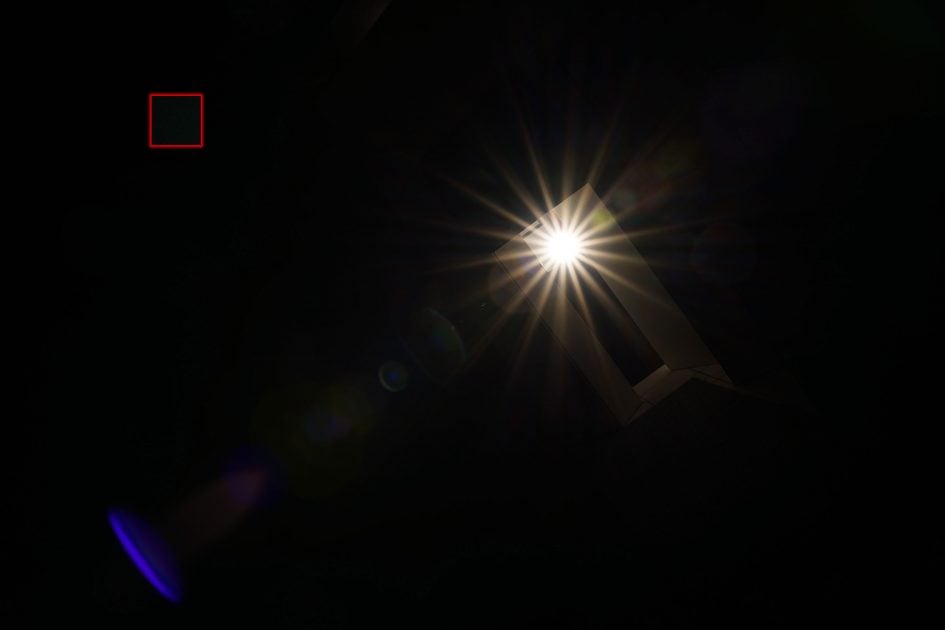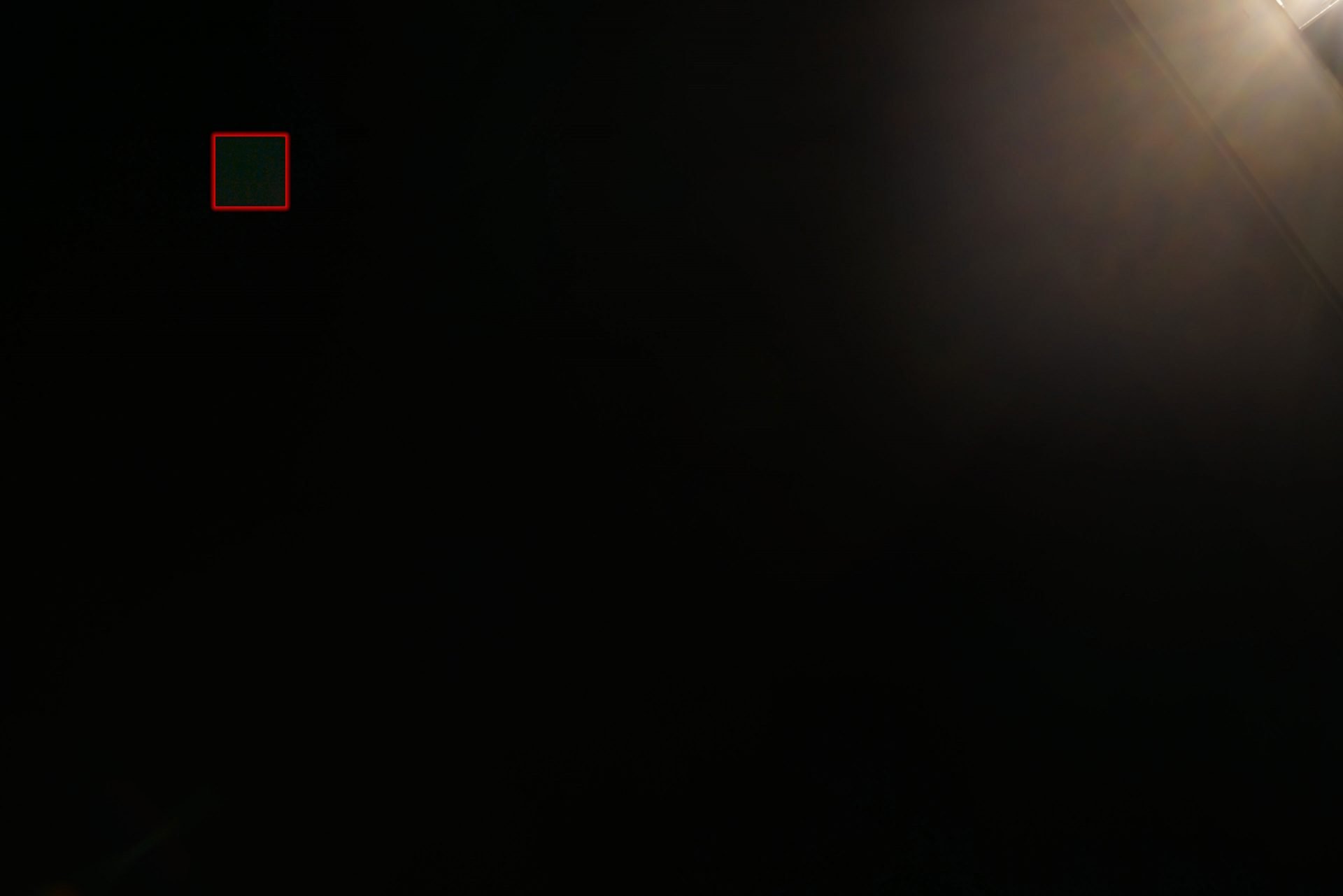Tamron 28-75mm f2.8 Di III G2 review
-
-
Written by Thomas
Quality
Longitudinal Chromatic Aberration and focus shift
Lenses with focal ratios of f2.8 or larger are often prone to longitudinal color aberrations (loCA, a.k.a. “axial color” or “bokeh CA”). These normally show up as magenta coloration in the foreground and greenish hues in the background and are not easily corrected in post-processing. The new Tamron shows a bit of loCA but no focus shift when stopped down.
Tamron 28-75mm f2.8 Di III G2 Longitudinal Chromatic Aberration (loCA)
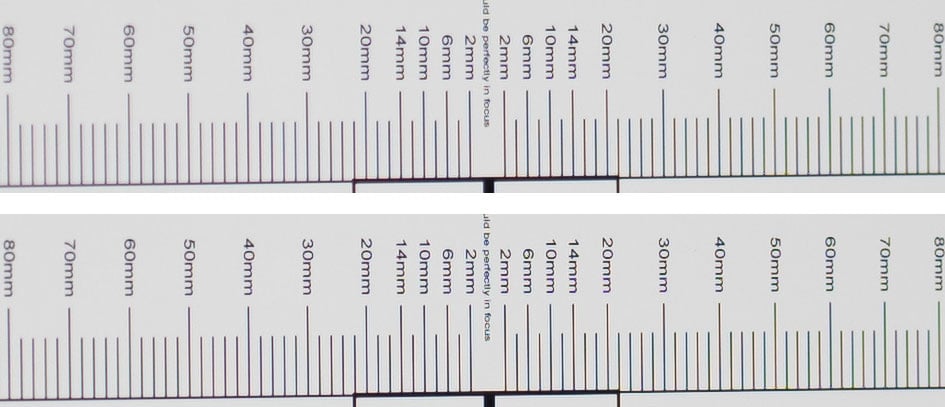
100% crops at 75mm f2.8 (top), f4.0 (bottom); left = foreground, right = background
The following 100% crop from a real life shot shows that the Tamron 28-75mm f2.8 Di III G2 produces a bit of glare and purple fringing around high-contrast edges in the focal plane plus some green outlining around background subjects:
Above: Tamron 28-75mm f2.8 Di III G2 at 75mm f2.8, 100% crop, click image for 4k version, here for large original
Sharpness and contrast
Let’s have a look at the theoretical performance of the new Tamron 28-75mm f2.8 Di III G2 and compare it to its predecessor and some other lenses:
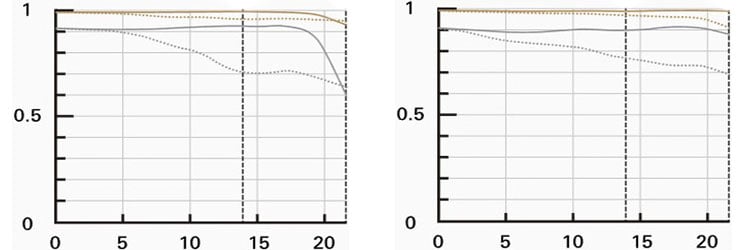
Above: Tamron 28-75mm f2.8 Di III G2, 28mm f2.8 (left), 75mm f2.8 (right)
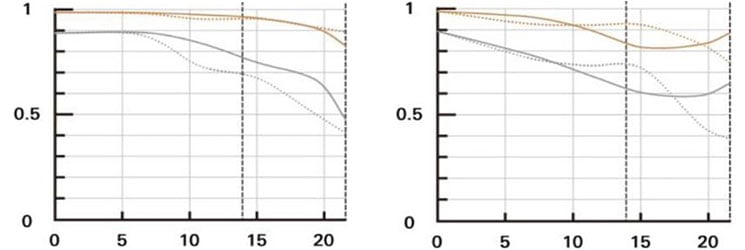
Above: Tamron 28-75mm f2.8 Di III (1st generation), 28mm f2.8 (left), 75mm f2.8 (right)
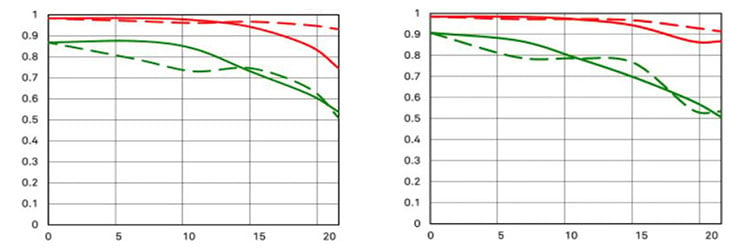
Above: Sigma 24-70mm f2.8 DG DN Art, 24mm f2.8 (left), 70mm f2.8 (right)
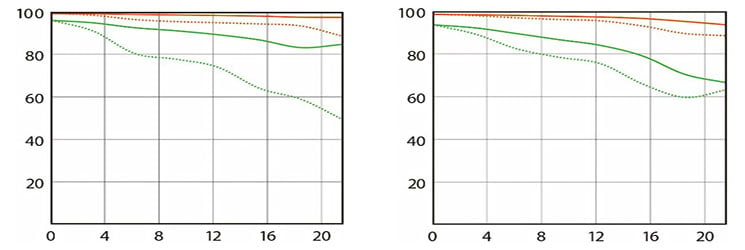
Above: Sony FE 24-70mm f2.8 GM, 24mm f2.8 (left), 70mm f2.8 (right)
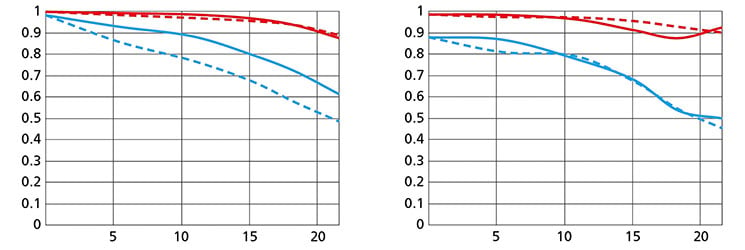
Above: Nikon Z 24-70mm f2.8 S, 24mm f2.8 (left), 70mm f2.8 (right)
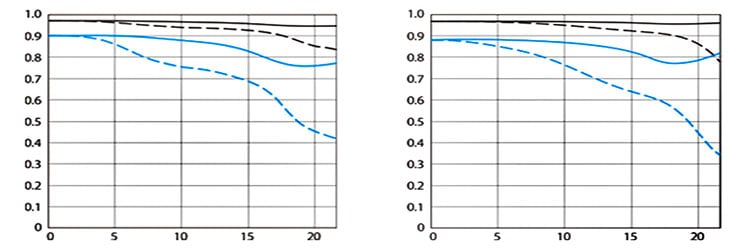
Above: Canon RF 24-70mm f2.8L IS, 24mm f2.8 (left), 70mm f2.8 (right)
These MTF charts show the computed lens-performance of lenses wide open without influence of diffraction at 10 line-pairs/mm (yellow/red) and 30 lp/mm (gray/blue/green). Higher values are better (more contrast) and the closer the dotted and solid lines are together the less contrast dependents on the orientation of the test-pattern (less astigmatism). The x-axis displays the distance from the optical axis (=center of the sensor) in mm.
The Tamron 28-75mm f2.8 Di III G2 looks clearly better than its predecessor. And it seems pretty close to or even surpassing some of the other lenses – at least on paper.
Let’s see how this theoretical performance translates into real life results in the sharpness test based on Siemens-stars shot on a 42MP Sony A7R II. Processing was done in Lightroom 11.0/CRAW 14.0 from RAW to Adobe Color profile with the built-in lens profile for CA and shading compensation applied. Noise-reduction is set to 0, sharpening to 50/0.5/36/10, with no extra tone, color, or saturation adjustment. White-balance was adjusted to a neutral white and I did some exposure compensation to make the brightness of all crops match. So you will not see light fall-off in the corners.
The following are all 100% crops!
First up is an overview of the wide-open performance at different focal lengths. You can jump to the detailed results at different apertures and comparisons with other lenses by clicking on the crops of the respective focal length.
Tamron 28-75mm f2.8 Di III G2; 100% crop from center, APS-C-corner, FF-corner
Above: 28mm, f2.8
Above: 35mm, f2.8
Above: 50mm, f2.8
Above: 75mm, f2.8
Tamron’s new zoom lens performs very well at the short end – even delivering quite good resolution in the FF-corner. Zooming in towards the long end makes the FF-corner become progressively softer. The APS-C-corner holds up a bit longer, but at 75mm becomes also quite soft and shows some lateral color aberrations. Field curvature is strongest at 28mm and still relevant at 35mm focal length. But at 50mm and beyond it’s practically negligible.
The following 100% crops for each focal length show the Tamron 28-75mm f2.8 Di III G2 from wide open down to f11 compared to the Tamron 28-75mm f2.8 Di III (1st Generation), Sigma 24-70mm f2.8 DG DN Art, Sony FE 24-70mm f2.8 GM, and Nikon Z 24-70mm f2.8 S – in case the new Tamron becomes available for Z-mount too. The Nikon was shot on a Nikon Z7 with a 4% higher linear resolution which makes these test-shots still very much comparable.
If you want to see all the details and comparisons read on. Or you can fast-forward to the performance at long distances.
Performance at 28mm:
Tamron 28-75mm f2.8 Di III G2 at 28mm compared; 100% crop from center, APS-C-corner, FF-corner

Above: Tamron 28-75mm f2.8 Di III G2 at 28mm, f2.8

Above: Tamron 28-75mm f2.8 Di III (1st Generation) at 28mm, f2.8; also available at f4.0, f5.6, f8.0

Above: Sigma 24-70mm f2.8 DG DN Art at 28mm, f2.8; also available at f4.0, f5.6, f8.0

Above: Sony FE 24-70mm f2.8 GM at 28mm, f2.8; also available at f4.0, f5.6, f8.0

Above: Nikon Z 24-70mm f2.8 S on a Nikon Z7 at 28mm, f2.8; also available at f4.0, f5.6, f8.0

Above: Tamron 28-75mm f2.8 Di III G2 at 28mm, f4.0

Above: Tamron 28-75mm f2.8 Di III G2 at 28mm, f5.6; also available at f8.0, f11
The new Tamron clearly beats its predecessor and also the other lenses in this comparison with the sharpest FF-corner.
Performance at 35mm:
Tamron 28-75mm f2.8 Di III G2 at 35mm compared; 100% crop from center, APS-C-corner, FF-corner

Above: Tamron 28-75mm f2.8 Di III G2 at 35mm, f2.8

Above: Tamron 28-75mm f2.8 Di III (1st Generation) at 35mm, f2.8; also available at f4.0, f5.6, f8.0

Above: Sigma 24-70mm f2.8 DG DN Art at 35mm, f2.8; also available at f4.0, f5.6, f8.0

Above: Sony FE 24-70mm f2.8 GM at 35mm, f2.8; also available at f4.0, f5.6, f8.0

Above: Nikon Z 24-70mm f2.8 S on a Nikon Z7 at 35mm, f2.8; also available at f4.0, f5.6, f8.0

Above: Tamron 28-75mm f2.8 Di III G2 at 35mm, f4.0

Above: Tamron 28-75mm f2.8 Di III G2 at 35mm, f5.6; also available at f8.0, f11
At 35mm focal length the new Tamron softens just a bit in the FF-corner while the Sony and Nikon sharpen up a bit which makes those three lenses pretty comparable. The older Tamron and the Sigma are clearly behind in the FF-corner.
Performance at 50mm:
Tamron 28-75mm f2.8 Di III G2 at 50mm compared; 100% crop from center, APS-C-corner, FF-corner

Above: Tamron 28-75mm f2.8 Di III G2 at 50mm, f2.8

Above: Tamron 28-75mm f2.8 Di III (1st Generation) at 50mm, f2.8; also available at f4.0, f5.6, f8.0

Above: Sigma 24-70mm f2.8 DG DN Art at 50mm, f2.8; also available at f4.0, f5.6, f8.0

Above: Sony FE 24-70mm f2.8 GM at 50mm, f2.8; also available at f4.0, f5.6, f8.0

Above: Nikon Z 24-70mm f2.8 S on a Nikon Z7 at 50mm, f2.8; also available at f4.0, f5.6, f8.0

Above: Tamron 28-75mm f2.8 Di III G2 at 50mm, f4.0

Above: Tamron 28-75mm f2.8 Di III G2 at 50mm, f5.6; also available at f8.0, f11
At 50mm the APS-C corner of the new Tamron softens up just a little but still performs slightly better than the Sigma and Sony. The Nikon takes the lead here across the sensor. Stop the new Tamron down to f4.0 or f5.6 to give the corners a visible lift and get rid of the chromatic aberrations
Performance at 75mm:
Tamron 28-75mm f2.8 Di III G2 at 75mm compared; 100% crop from center, APS-C-corner, FF-corner

Above: Tamron 28-75mm f2.8 Di III G2 at 75mm, f2.8

Above: Tamron 28-75mm f2.8 Di III (1st Generation) at 75mm, f2.8; also available at f4.0, f5.6, f8.0

Above: Sigma 24-70mm f2.8 DG DN Art at 70mm, f2.8; also available at f4.0, f5.6, f8.0

Above: Sony FE 24-70mm f2.8 GM at 70mm, f2.8; also available at f4.0, f5.6, f8.0

Above: Nikon Z 24-70mm f2.8 S on a Nikon Z7 at 70mm, f2.8; also available at f4.0, f5.6, f8.0

Above: Tamron 28-75mm f2.8 Di III G2 at 75mm, f4.0

Above: Tamron 28-75mm f2.8 Di III G2 at 75mm, f5.6; also available at f8.0, f11
At 75mm Tamron’s 28-75mm f2.8 Di III G2 zoom lens falls slightly behind its predecessor although it still shows a pretty sharp center. It performs comparable to the Sony, but the Sigma and especially the Nikon are better at the long end. Stopping down does not clean the FF-corner up by much as the chromatic aberrations are still visible at f11.
Overall the Tamron 28-75mm f2.8 Di III G2 performs nicely in this test, especially at the short end – where it matches or beats all competitors. This is quite a feat. And it holds up pretty well in the medium focal lengths. It’s only at 75mm where it falls back a bit in absolute sharpness and also compared to the best competitors.
Performance at long distances
The Siemens-star test-targets are shot at a distance of 45x focal length (i.e. at around 9m for 200mm focal length). But performance of lenses also depends on the shooting distance. Therefore I present another series of images shot on a 42MP Sony A7R II of a city around 1 km away. Processing was done in Lightroom 11.0/CRAW 14.0 from RAW to Adobe Color profile with the built-in lens profile compensating CA and vignetting. Noise-reduction is set to 0, sharpening to 50/0.5/36/10, with no extra tone, color, or saturation adjustment. All shots were made from a heavy tripod with image stabilization switched off. As usual I have selected the diagonal that provided the better corner results as the lens was a bit decentered.
The following images show the complete scene wide open to give you an impression of the angle of view. Following each main image are 100% crops from the center, APS-C-corner, and FF-corner. You can access the large originals but please respect our copyright and only use those images for personal use.
Tamron 28-75mm f2.8 Di III G2; 100% crop from center, APS-C-corner, FF-corner

Above: Tamron 28-75mm f2.8 Di III G2 at 28mm, f2.8; click image for 4k version, here for large original; crops also available at f4.0, f5.6, f8.0

Above: Tamron 28-75mm f2.8 Di III G2 at 35mm, f2.8; click image for 4k version, here for large original; crops also available at f4.0, f5.6, f8.0

Above: Tamron 28-75mm f2.8 Di III G2 at 50mm, f2.8; click image for 4k version, here for large original; crops also available at f4.0, f5.6, f8.0

Above: Tamron 28-75mm f2.8 Di III G2 at 75mm, f2.8; click image for 4k version, here for large original; crops also available at f4.0, f5.6, f8.0
The Tamron 28-75mm f2.8 Di III G2 again performed very well in this long-distance test: Up to 50mm focal length the lens produces sharp results right into the corner of the full-frame sensor. Only at 75mm results outside the center are a bit softer but stopping down to f4.0 already gives a nice boost in acuity.
Vignetting and distortions
To make it easier to see light fall-off in the corners of a full-frame sensor I’ve arranged a series of three shots each with the Tamron 28-75mm f2.8 Di III G2 from f2.8 to f5.6 at 28mm and 75mm focal length. All images were developed to the same brightness in the center and with the built-in lens profile compensating vignetting:
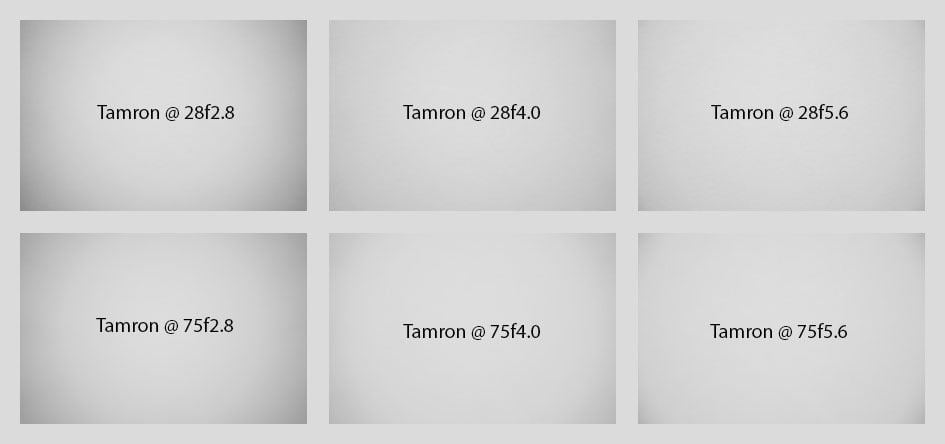
Above: Tamron 28-75mm f2.8 Di III G2 at 28mm and 75mm focal length; shading compensation = Auto
The sample images above show that with the lens profile applied vignetting is clearly visible wide open although automatic shading compensation lifts the extreme corners by 1 EV. Adobe’s RAW converter automatically applies shading compensation as it was set in camera – but you cannot alter the setting in postprocessing.
Distortions show a slight mustachio at 28mm and evolve to a strong pin-cushion type at 75mm focal length. The setting for distortion compensation in camera is currently ignored by Adobe’s RAW converter and treated as OFF but there is a lens profile for the lens in Lightroom 11.0 / CRAW 14.0. If you activate Adobe’s lens profile just dial vignetting compensation back if you already had shading compensation in camera set to Auto. This is all pretty confusing and I can only hope that one day Adobe and the lens/camera makers can agree upon which part of the lens profile is automatically applied in RAW development and which part has to be activated manually in post-processing. But Adobe’s lens profile at least does a pretty good job to correct for distortions – as does the distortion compensation in camera when you shoot JPGs:
Distortions: Tamron 28-75mm f2.8 Di III G2 at 28mm, as is (top) / with lens-profile (bottom)
Distortions: Tamron 28-75mm f2.8 Di III G2 at 75mm, as is (top) / with lens-profile (bottom)
Rendering of point-light sources at night-shots
Night-shots pose a different challenge for lenses as the contrast is even higher than under bright sun and point-light sources can reveal some weaknesses such as coma, haloing and colour-aberrations that do not show up as prominently in other test-shots. The 100% crops below the main image show the effect of coma in the FF-corner of the Tamron 28-75mm f2.8 Di III G2:
Above: Tamron 28-75mm f2.8 Di III G2 at 28mm, f2.8; click image for 4k version, here for large original

Above: Tamron 28-75mm f2.8 Di III G2 at 28mm; 100% crops from the FF-border at f2.8 (left), f4.0 (middle), f5.6 (right)
The lens is practically free of coma but it shows a touch of colored haloes around bright lights.
Bokeh quality
This test is for the rendering of point-light sources in an out-of-focus background. The circle of confusion that is produced by this test is pretty indicative of Bokeh performance (in the background) and light fall-off. Ideally the out-of-focus image of the point-light is evenly lit and perfectly circular, with no “onion-rings”, and without coloration. There’s also an effect known as “cat’s eye” the further away from the optical axis the point-light is projected. This is due to optical vignetting in the lens barrel when light enters the lens from an angle.
The images were shot at the longest focal length. Crops are from the center, APS-C-corner, and FF-corner resized to make them comparable across all my reviews.
Above: Tamron 28-75mm f2.8 Di III G2 at 75mm, f2.8; click image for 4k version
Above: Tamron 28-75mm f2.8 Di III G2 at 75mm, f2.8; click image for 100% crops
Above: Tamron 28-75mm f2.8 Di III G2 at 75mm, f4.0; click image for 100% crops
Above: Tamron 28-75mm f2.8 Di III G2 at 75mm, f5.6; click image for 100% crops
The diameter of the Bokeh balls in the center is determined by the entrance pupil of the lens which is 27mm for the Tamron 28-75, just a tad larger than from f2.8 zoom lenses at 70mm. The Bokeh balls from Tamron’s 28-75mm f2.8 Di III G2 are free of onion-rings but show a “bubbly” texture inside and some outlining with no coloration from loCA. They stay pretty circular in the center up to f5.6 and the cat’s eye effect is very mild in the APS-C-corner but becomes very strong wide open in the FF-corner.
Now let’s see how this analysis of out-of-focus point-light sources translates into Bokeh-performance shooting a book-shelf. Crops are from the foreground, middle-ground, and background resized to make them comparable across all my reviews.
Above: Tamron 28-75mm f2.8 Di III G2 at 75mm, f2.8; click image for 4k version, here for large original
Above: Tamron 28-75mm f2.8 Di III G2 at 75mm, f2.8; click image for 4k version, here for large original
Above: Tamron 28-75mm f2.8 Di III (1st generation) at 70mm, f2.8; click image for 4k version, here for large original
Above: Sigma 24-70mm f2.8 DG DN Art at 70mm, f2.8; click image for 4k version, here for large original
Above: Sony FE 24-70mm f2.8 GM at 70mm, f2.8; click image for 4k version, here for large original
Above: Nikon Z 24-70mm f2.8 S on a Nikon Z7 at 70mm, f2.8; click image for 4k version, here for large original
Bokeh of Tamron’s new 28-75mm f2.8 Di III G2 looks a bit softer than from its predecessor and is similar to the Sigma. But it’s not quite as soft as from the Sony or Nikon. The transition zone is free of color artifacts and double contours are relatively weak (see below).

Above: Tamron 28-75mm f2.8 Di III G2 at 75mm, f2.8, 100% crop; click image for 4k version, here for large original
Close-up performance
The Tamron 28-75mm f2.8 Di III G2 achieves a pretty decent magnification of around 1:3 (depending on focal length) in close-up shooting. The following images were shot at 1:4 magnification where the area of sharp focus is just 144 x 96mm. The crops shown below are from 0mm, 12mm, and 18mm off the center of the sensor respectively. The first set was shot at 28mm focal length, the second set at 75mm.

Above: Tamron 28-75mm f2.8 Di III G2 at 28mm, f2.8; 100% crops

Above: Tamron 28-75mm f2.8 Di III G2 at 28mm, f5.6; 100% crops

Above: Tamron 28-75mm f2.8 Di III G2 at 28mm, f11 100% crops
The lens is pretty sharp in the center even wide open. But for a larger area of good sharpness you need to stop down to at least f11. Sharpness is strongly effected by field-curvature so you could achieve sharper results outside the center by specifically focusing there. See the following example shot at f8, where the crops at 12mm and 18mm image height were separately focused. This is better but the crops outside the center still look mushy:

Above: Tamron 28-75mm f2.8 Di III G2 at 28mm, f8; 100% crops
Using the lens at 75mm focal length produces much better results outside the center with only little field-curvature. The following images were also shot at 1:4 magnification with crops from 0mm, 13mm, and 18mm off the center of the sensor respectively:

Above: Tamron 28-75mm f2.8 Di III G2 at 75mm, f2.8; 100% crops

Above: Tamron 28-75mm f2.8 Di III G2 at 75mm, f5.6; 100% crops

Above: Tamron 28-75mm f2.8 Di III G2 at 75mm, f11; 100% crops
F5.6 now looks at least usable – especially when you put your subject in the APS-C image-circle. And specifically focusing for each crop does not improve image quality much further:

Above: Tamron 28-75mm f2.8 Di III G2 at 75mm, f8; 100% crops
Flare, ghosting, and sun-stars
Catching a strong light-source shining directly into the lens is always a risky business: it could produce strange colorful ghost-images or reduce contrast considerably through flare and glare. The appearance of flare and ghosting depends on factors like the aperture and the angle of the light hitting the lens. So to judge the proclivity of the new Tamron 28-75mm f2.8 Di III G2 for these artifacts I went through a series of well calculated shots against a strong light source to provoke glare and ghosting. The lens hood was mounted in all shots. Following are just two examples at different apertures and angles. The little bright square inset in the upper left shows the respective area with an exposure compensation of +3 EV to make it easier to see which levels of black the lens renders at that point:
Above: Strong light hitting the Tamron 28-75mm f2.8 Di III G2 at 28mm, f11; click image for 4k version or here for +3 EV exposure compensation
Above: Strong light hitting the Tamron 28-75mm f2.8 Di III G2 at 75mm, f11; click image for 4k version or here for +3 EV exposure compensation
The Tamron 28-75mm f2.8 Di III G2 produces some ghosting artifacts but they are not very bright. And veiling glare is well suppressed. So you can confidently shoot the lens even under adverse contra-light situations.
Sunstars are very weak at f5.6 but develop nicely when the lens is stopped down to f8.0 or better yet f11:

Above: Sunstars from the Tamron 28-75mm f2.8 Di III G2 at 28mm, f5.6 (left), f8.0 (right), 100% crops
Next check out my sample images!
Check prices on the Tamron 28-75mm f2.8 Di III G2 at B&H, Adorama, WEX UK or Calumet.de. Alternatively get yourself a copy of my In Camera book or treat me to a coffee! Thanks!
